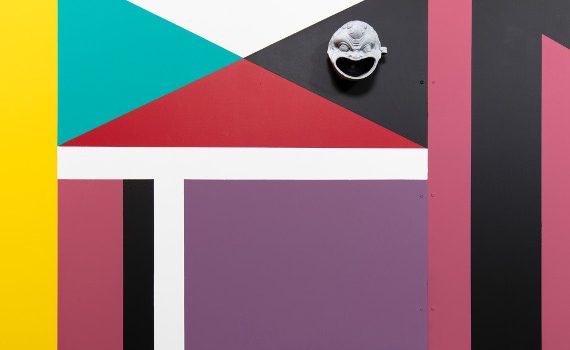The exhibition at the House of the Cryptoporticus is hosted in one of the underground corridors of the domus and consists of two original installations that dialogue with the Roman frescoes.
The first installation brings together the painting series in the underground corridor of the Cryptoporticus with the colonnade painted by Catrin Huber. The decorated area is a kaleidoscope of rhythmic colours that recreates real and illusionistic architectures. Huber also includes replicas of Roman objects from everyday life such as oil lamps and face pots, which bridge the ancient Roman world and the contemporary world in a new form of design.
The second installation is in the private bathhouse of the domus with its richly painted, complex and illusionistic frescoes. Contemporary paintings, in turn, react with a complex game of 2D and 3D space, openings and arches, interiors and exteriors, and tricky shifts in perspective.
In parallel with the exhibition in Pompeii, Expanded Interiors, in the House of the Beautiful Courtyard in Herculaneum, investigates material culture in ancient Rome and looks at exhibition methods in contemporary terms (from 16th May 2018 to 15th January 2019).
“By investigating two distinctive Roman houses – Catrin Huber says – our project sets out an exchange of knowledge between old and new. We are exploring what contemporary painting and site-specific fine-art practice can learn from the often incredibly sophisticated and complex works of the Roman wall painters. Combining fine-art practice and archaeological investigation, 3D digital scanning and printing, the Expanded Interiors project provides a new perspective on the spatial configurations of ancient Roman homes and the artefacts that adorned them.”
“The archaeological Pompeii, the ancient city brought back to light, is living its own life – Massimo Osanna states – the contemporary life, that continues to affect people and artists in the present. Catrin Huber’s installation is an example of how much Pompeii's charm and splendour can still be an inspiration for artistic souls, generating original creative processes.”
Expanded Interiors, led by visual artist Catrin Huber and promoted by Newcastle University in the city where Catrin lives, is funded by the AHRC (Arts & Humanities Research Council), in cooperation with the Archaeological Park of Pompeii, the Archaeological Park of Herculaneum, the Herculaneum Conservation Project, and Art Editions North.
The team brings together the artists, archaeologists, and digital technology experts Catrin Huber (artist), Prof. Ian Haynes (archaeologist), Rosie Morris (artist), Dr Thea Ravasi (archaeologist), Alex Turner (archaeologist and digital technology expert).
www.expandedinteriors.co.uk
#expandedinteriors
@ExpandedIN
NOTES ABOUT THE ARTIST
Catrin Huber is a German-born artist now based in Newcastle (England). In 2008, she was awarded an Abbey Fellowship at the British Academy in Rome, which allowed her to get in-depth knowledge of the works of ancient Roman painters. Huber has already staged exhibitions in Great Britain (including the two London-based Barbican Centre and Sartorial Contemporary Art, among others) and abroad (Akademie Schloss Solitude in Stuttgart, Kunstverein Wilhelmshöhe in Ettlingen, and the RMIT Project Space in Melbourne). She has won many awards and scholarships from entities such as DAAD, Royal College of Art (John Crane Travel Award), and the Land Baden-Württemberg (Cité Internationale des Arts, Paris). Huber studied painting at the Staatliche Akademie der Bildenden Künste in Karlsruhe and at the Royal College of Art in London.


